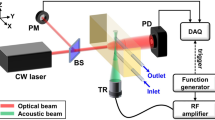The use of laser diodes and photodiodes in transmission spectroscopy has some effects (temperature, time, spectral, and spatial) reducing the accuracy of glucose measurement. These effects can be reduced by using a (1600 ± 3) nm laser in combination with fixation and occlusion of the tissue area under examination. In this work, a method is suggested that allows spatial displacements of the system to be taken into account. A number of methods for reducing the effect of the thermal drift of the diodes are also suggested. A portable noninvasive optical glucose meter implemented using these methods provides high clinical performance: more than 97% of the measurements are in the A and B zones of the Parkes error grid.
Similar content being viewed by others
References
Knorre, D. G. and Myzina, S. D., Biological Chemistry [in Russian], Vysshaya Shkola, Moscow (2000).
Kadish, A. H., “Automation control of blood sugar: A servomechanism for glucose monitoring and control,” ASAIO J., 9, No. 1, 363-367 (1963).
Pfeiffer, E. F., Thum, C., and Clemens, A. H., “The artificial beta cell – A continuous control of blood sugar by external regulation of insulin infusion (glucose controlled insulin infusion system),” Horm. Met. Res., 6, 339-342 (1974).
Yatabe, T., Yamazaki, R., Kitagawa, H., et al., “The evaluation of the ability of closed-loop glycemic control device to maintain the blood glucose concentration in intensive care unit patients,” Crit. Care Med., 39, No. 3, 575-578 (2011).
Khalil, O. S., “Spectroscopic and clinical aspects of noninvasive glucose measurements,” Clin. Chem., 45, No. 2, 165-177 (1999).
Maruo, K., Oota, T., Tsurugi, M., Nakagawa, T., Arimoto, H., Tamura, M., Ozaki, Y., and Yamada, Y., “New methodology to obtain a calibration model for noninvasive near-infrared blood glucose monitoring,” Appl. Spectrosc., No. 60, 441-449 (2006).
Jacques, S. L., “Origins of tissue optical Properties in the UVA, visible, and NIR regions,” Adv. Opt. Imag. Phot. Migr., 2, 364-369 (1996).
Litinskaya, E. L., Bazaev, N. A., and Pozhar, K. V., “A thermostat module for the laser radiation source of a portable noninvasive optical glucose meter,” Mezhd. Nauch.-Issl. Zh., No. 7, Part 4, 30-33 (2016).
Bazaev, N. A., Grinval’d, V. M., Zhigaylo, A. N., Litinskaya, E. L., Pozhar, K. V., and Rudenko, P. A., “A test bench for performance validation of an artificial pancreas system,” Med.Tekh., No. 6, 33-36 (2017).
Parkes, J. L., Slatin, S. L., Pardo, S., and Ginsberg, B. H., “A new consensus error grid to evaluate the clinical significance of inaccuracies in the measurement of blood glucose,” Diabetes Care, 23, No. 8, 1143-1148 (2000).
Author information
Authors and Affiliations
Corresponding author
Rights and permissions
About this article
Cite this article
Pozhar, K.V. Transmission Spectroscopy in Noninvasive Blood Glucose Measurement. Biomed Eng 52, 247–250 (2018). https://doi.org/10.1007/s10527-018-9823-y
Published:
Issue Date:
DOI: https://doi.org/10.1007/s10527-018-9823-y




